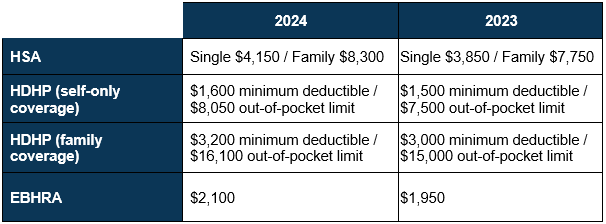
Is the HSA Contribution Limit an Annual or Monthly Limit?
QUESTION: How does the general contribution limit for HSAs work? It is often stated as an annual limit, but isn’t it really monthly? Our company is thinking about changing to HDHP coverage that would allow our employees to make HSA contributions. If we decide to facilitate those HSA contributions or to make employer contributions, would we need to limit the amount of contributions made each month, or only annually?
ANSWER: The general contribution limit for HSAs is an annual limit determined by the number of months of HSA eligibility. The HSA of an individual who is HSA-eligible for the entire year can receive contributions (from any source) up to the full annual limit. If an individual is only HSA-eligible for a portion of the year, the annual limit is prorated based on the number of months of HSA eligibility. A special rule that can change this outcome is noted below.
For example, if Ana, a 40-year-old calendar-year taxpayer, is HSA-eligible for all of 2023 and has self-only HDHP coverage, her HSA can receive contributions of up to the maximum of $3,850 for 2023. (For coverage other than self-only coverage, the maximum for 2023 is $7,750.) If Ana were only HSA-eligible for April through September, however, her annual limit would be 6/12ths of the full annual limit, or $1,925. That $1,925 could be contributed in one month, or in any number of payments made on or after January 1, 2023, and on or before the filing due date (without extensions) for Ana’s 2023 federal tax return. Some or all of the permitted amount could be contributed during a month in which Ana is not HSA-eligible, based on her prior or anticipated months of HSA eligibility. (Of course, contributions could not be made until Ana’s HSA is established, if it wasn’t established by January 1st.) A similar proration rule applies to HSA catch-up contributions, which increase the general contribution limit for HSA-eligible individuals who have attained age 55 by the end of the taxable year. Thus, if Ana were at least age 55 by the end of 2023, and she were HSA-eligible for the entire year, her limit would be increased by $1,000. But if she were HSA-eligible for only 6 months of 2023, her catch-up contribution limit would be only $500.
Employers that facilitate employee contributions or make their own contributions to employees’ HSAs need not limit the amount actually contributed in each month, but they do have to track their employees’ HSA eligibility on a monthly basis so they can determine any prorated limit amount. Employers are only responsible for knowing how their own benefit programs affect HSA eligibility and whether an employee is eligible for catch-up contributions. They need not determine whether employees have disqualifying coverage from other sources or how much has been contributed to employees’ HSAs by other means.
As noted above, special contribution rules can apply when determining a particular employee’s limit. One of these is the “full contribution rule,” which allows calendar-year taxpayers to be treated as HSA-eligible for the entire year if they are HSA-eligible on December 1st, subject to certain conditions that include remaining HSA-eligible for at least a 13-month testing period. There is also a special rule for married individuals if either spouse has family HDHP coverage.
Source: Thomson Reuters




